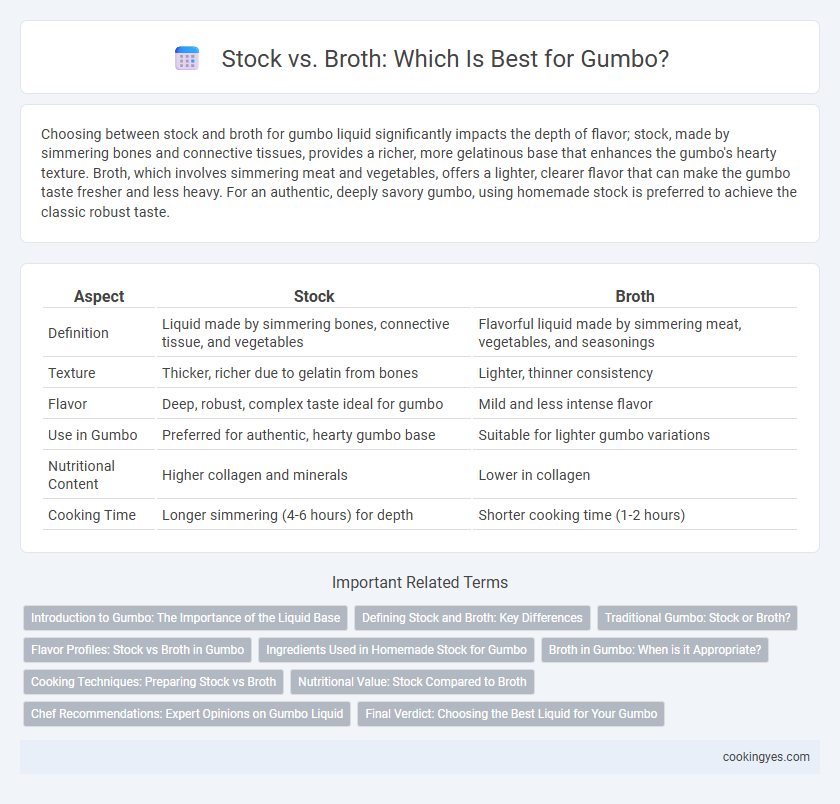Choosing between stock and broth for gumbo liquid significantly impacts the depth of flavor; stock, made by simmering bones and connective tissues, provides a richer, more gelatinous base that enhances the gumbo's hearty texture. Broth, which involves simmering meat and vegetables, offers a lighter, clearer flavor that can make the gumbo taste fresher and less heavy. For an authentic, deeply savory gumbo, using homemade stock is preferred to achieve the classic robust taste.
Table of Comparison
| Aspect | Stock | Broth |
|---|---|---|
| Definition | Liquid made by simmering bones, connective tissue, and vegetables | Flavorful liquid made by simmering meat, vegetables, and seasonings |
| Texture | Thicker, richer due to gelatin from bones | Lighter, thinner consistency |
| Flavor | Deep, robust, complex taste ideal for gumbo | Mild and less intense flavor |
| Use in Gumbo | Preferred for authentic, hearty gumbo base | Suitable for lighter gumbo variations |
| Nutritional Content | Higher collagen and minerals | Lower in collagen |
| Cooking Time | Longer simmering (4-6 hours) for depth | Shorter cooking time (1-2 hours) |
Introduction to Gumbo: The Importance of the Liquid Base
Gumbo relies heavily on its liquid base, where the choice between stock and broth significantly influences the dish's depth and richness. Stock, typically made by simmering bones and vegetables, provides a robust, gelatinous texture that enhances the gumbo's body and mouthfeel. Broth, seasoned and lighter, offers a clearer, more delicate flavor that can highlight the freshness of seafood or vegetables in the gumbo.
Defining Stock and Broth: Key Differences
Stock for gumbo is a flavorful liquid made by simmering bones, vegetables, and aromatics, resulting in a rich, gelatinous base that adds depth and body to the dish. Broth, on the other hand, is typically made by simmering meat, vegetables, and seasonings, producing a lighter and clearer liquid with a more delicate flavor. Choosing stock over broth for gumbo enhances the overall texture and complexity, ensuring a more robust and satisfying gumbo experience.
Traditional Gumbo: Stock or Broth?
Traditional gumbo relies on a rich, deeply flavored stock made by simmering bones, vegetables, and seasonings, which provides the essential depth and body characteristic of authentic gumbo. Broth, being lighter and less concentrated, lacks the robust texture and complexity needed to develop the gumbo's signature hearty and soulful taste. Using homemade chicken, beef, or seafood stock enhances the gumbo's layered flavors, making it superior to store-bought broth options.
Flavor Profiles: Stock vs Broth in Gumbo
Stock offers a richer, more concentrated flavor profile for gumbo due to its prolonged simmering with bones and aromatic vegetables, which extracts gelatin and deep umami notes essential for a hearty gumbo base. Broth, being lighter and clearer, imparts a milder taste with less depth, often resulting in a sharper and less complex flavor that can underwhelm traditional gumbo expectations. For an authentic gumbo experience, using homemade stock enhances the overall texture and richness, elevating the dish's characteristic robust and savory flavors.
Ingredients Used in Homemade Stock for Gumbo
Homemade stock for gumbo typically features a rich blend of ingredients such as chicken bones, beef bones, or shellfish shells, combined with aromatic vegetables like onions, celery, and bell peppers. Simmering these components for several hours extracts deep flavors and gelatin, creating a thicker and more savory liquid compared to broth. Herbs like thyme, bay leaves, and crushed garlic enhance the stock's complexity, making it the preferred base for authentic gumbo recipes.
Broth in Gumbo: When is it Appropriate?
Broth in gumbo provides a lighter, more delicate flavor compared to the rich, concentrated taste of stock, making it suitable for seafood or chicken gumbo varieties where subtlety enhances the dish. Using broth is appropriate when aiming for a quicker preparation time, as it is typically ready-made and requires less simmering than homemade stock. Choosing broth can also reduce fat content and provide clearer, cleaner-tasting liquid, balancing the spices and ingredients without overpowering them.
Cooking Techniques: Preparing Stock vs Broth
Stock for gumbo involves simmering bones, vegetables, and aromatics for several hours to extract deep, gelatin-rich flavors that create a thick, velvety base. Broth, on the other hand, is typically made by simmering meat and vegetables for a shorter time, resulting in a lighter, less concentrated liquid. Using stock enhances gumbo's richness and mouthfeel, while broth provides a subtler taste and thinner consistency.
Nutritional Value: Stock Compared to Broth
Stock for gumbo offers a richer nutritional profile due to its higher collagen and mineral content extracted from simmered bones, which supports joint health and provides essential nutrients like calcium and magnesium. Broth, typically made primarily from meat and vegetables, contains fewer minerals but retains a lighter protein content and is easier to digest. Choosing stock over broth enhances gumbo's depth in flavor while delivering greater nutritional benefits essential for a hearty, nutrient-dense dish.
Chef Recommendations: Expert Opinions on Gumbo Liquid
Chef recommendations emphasize using a rich, homemade stock rather than broth for gumbo liquid due to its deeper flavor complexity and fuller body. Expert chefs often choose a well-simmered chicken, seafood, or vegetable stock to enhance the gumbo's savory backbone, ensuring the seasoning layers fully develop. Broth, generally lighter and less concentrated, is usually considered insufficient for achieving the traditional robust gumbo taste preferred by culinary professionals.
Final Verdict: Choosing the Best Liquid for Your Gumbo
Stock provides a richer, more concentrated flavor essential for authentic gumbo, as it's simmered with bones and aromatics, enhancing depth and complexity. Broth is lighter and quicker to prepare, suitable for milder gumbo varieties or when a less intense taste is desired. For the best gumbo, homemade chicken or seafood stock is preferred to achieve the signature bold, hearty flavor that defines this classic Creole dish.
Stock vs broth for gumbo liquid Infographic

 cookingyes.com
cookingyes.com